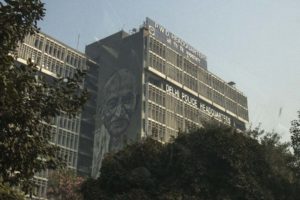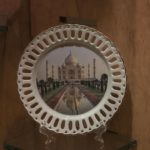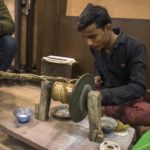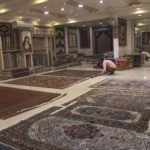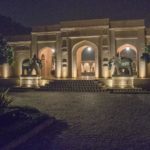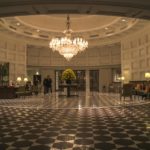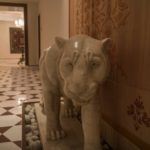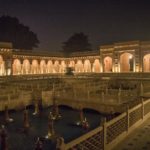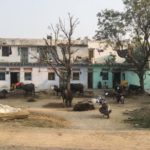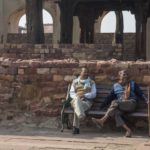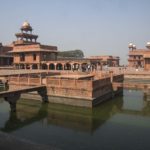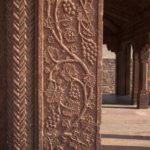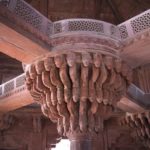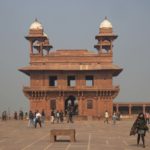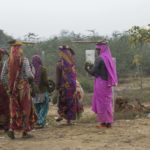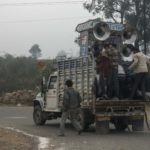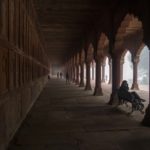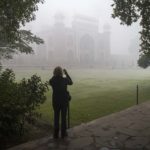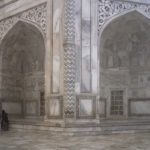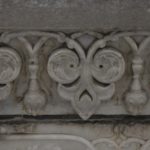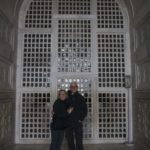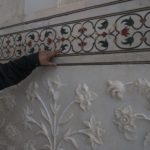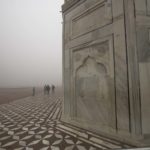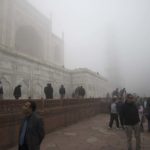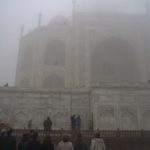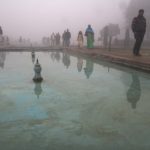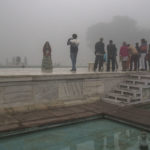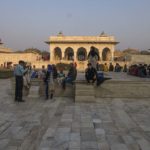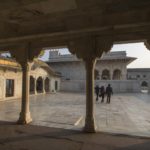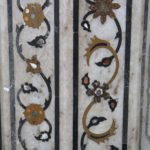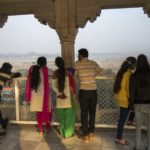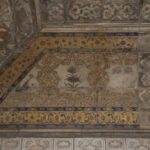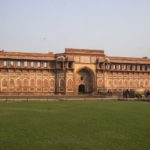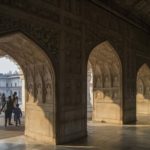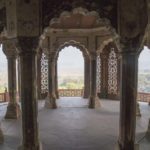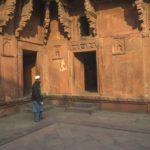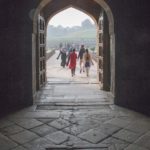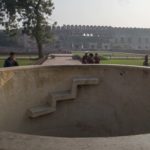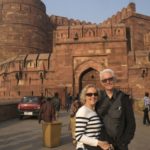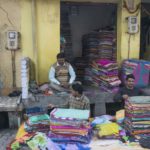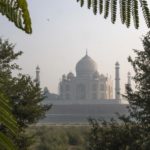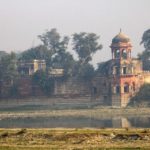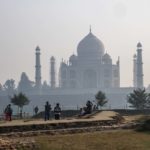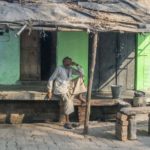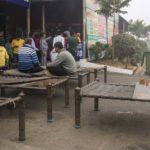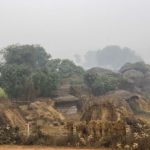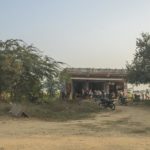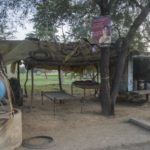Our drive to Agra did not begin at an early hour, for which we were grateful. Our driver, Anand, took us along the very new, privately owned Yamuna Expressway (it has three toll ways and they are building a fourth). This is one of the best roads in India, and has reduced what was once quite a lengthy drive to four hours (including stops for cups of tea). Of course, building the expressway has made the ‘day trip’ option for tourists going to Agra out of Delhi much easier. Interesting that the speed cameras along the route stop you getting through the toll ways if you are speeding. Great idea.
We stopped for a break to stretch our legs, use the bathrooms and try some of the local chai tea served in tiny clay pots. Have no idea of the name of this particular funky tasting chai, but it was smoky and bitter. The milk attempted to balance the flavours, but the taste wasn’t quite working for me, the non-tea drinker, but our driver loved it! The furniture for customers at the layby was surprising, but it was to become a familiar site throughout India. There were large rope and strap strung ‘beds’ surrounding the chai shop with a plank balanced across the middle. In a culture where there is complete ease and flexibility to sit on the ground, these were perfect for providing above the ground seats with some comfort and a flat surface for resting the teacups on, while sitting face to face with companions for a chat. And, of course, the planks were not secured on the frames, so they could be removed for a full stretch out and use of the bed for a snooze.
Mehtub Bagh
We met our guide for this city, Raj, and he began by taking us to Mehtub Bagh, the park on the other side of the river from the Taj Mahal with views of its rear (or its ‘backside’, as they say in India). There are a lot of foundations exposed here, and the rumour has it that the emperor, Shah Jahan, had plans to build a black Taj Mahal for himself, opposite the glorious white one for his wife. However, his son, Aurangzeb, staged a coup and his father was imprisoned for the rest of his life in the octagonal tower in the palace at Agra Fort. Shah Jahan lived another eight years, gazing from his luxurious marble balconies at the mausoleum where his wife was buried.
Agra Fort
While more a walled palatial city in terms of architecture than a fort, only 25% of Agra Fort is open to the public for viewing; the other 75% is used by the army. Its striking red sandstone (brought from nearby Fatehpur Sikri) forms the walls and many of the buildings within its city. Many of the actual palace sections, however, were added under Shah Jahan’s rule and are built from white marble with exquisite semi-precious stone inlay.
There is much to wonder at in this extravagant miniature city. Apparently a two-storey underground labyrinth of rooms exists beneath the courtyard where Emperor Akbar (who built the fort in 1565) housed is 500-strong harem. How much time and energy can one man have? In front of the red sandstone Jahangiri’s Mahal in the middle of the courtyard is Hauz-i-Jahangiri – a huge bowl that was carved out of a single block of stone and used for bathing. And the term ‘bowl’ doesn’t really give an idea of scale. The tub is 1.22m deep, 2.4m in diameter and 7.62m in circumference at the rim. John’s photo actually gives the illusion that it was much larger than it was due to the angle of the shot, but it was still massive.
Went to a cottage industry multi-storied shop that demonstrated carpet making (no pressure – lies!), the process of marble inlay, and explanations on the formation of star rubies. Fascinating technique for the marble inlay, but none of the salesmen were impressed that we were not interested in buying. The carpet guy tried earnestly to make a sale, showing us carpets large and small, silk bedspreads and whatever, but we just said, look, there is no point wasting more of your time, we are not shopping today. So he took us upstairs to the sections where we went through more of the same selling techniques. When our guide, Raj, got back in the car, he asked about our experience and what we thought about the place, and we said it was lovely stuff, but it was also expensive. His answer was to say he would take us somewhere cheaper tomorrow. No thank you. Not really feeling it with the shopping in this town, especially when Anand has already told us that we will find better value and quality in Jaipur and Jodhpur. And, to be honest, we didn’t come to Agra to shop.
Overnight in Agra
Our accommodation in Agra was at The Coral Tree Homestay, a cheap little place that was ranked #1 on TripAdvisor. As to be expected in a low-budget B&B, our room was minimal, but a good size, and brightly decorated. We had to turn on the tiny hot water system as soon as we checked in to ensure it was ready for the next morning. The bed was a thin mattress on boards, but as I don’t mind a firm bed, it was quite comfortable. The internet was quite patchy, which was a surprise – often places that appeal to younger, back-packer types have excellent wifi.
One of the reasons for wanting to stay at The Coral Tree (apart from the low price and hopes of Indian authenticity) was the reputation they had for their cooking. Unfortunately, when we requested dinner at 8pm after seeing the planned cultural dance show, we were told that that was a bit too late. This response was surprising, as most restaurants open at 7pm for dinner. Oh well, not a problem, we would find somewhere else to eat after the show. But when we returned from our dinner at 9:30pm, there was a couple in the dining room just finishing their apparently delicious home cooked meal. Cheers.
Evening entertainment
On Anand’s suggestion, that evening we went along to the theatrical dance show, Mohabbat the Taj, at the Kalakriti Cultural Centre. This ‘Saga of Love’ is the love story behind the building of the Taj Mahal. The production was a showcase of fancy lighting, beautiful costumes, mimed dialogue and over the top Bollywood acting to stage its theatrical journey. It felt too long, but the dance numbers were colourful and well choreographed (if not well danced! – except for one woman, who was fabulous). For me, the highlight was a scale model of the Taj Mahal made from the same type of marble as the original and weighing 8 tonnes. Shame that photography was not allowed.
We decided to treat ourselves in our choice of restaurant for dinner – the Bellevue in the Oberoi Hotel; fine dining Indian cuisine at its best. There was also the option of a fine dining western menu, but why bother? Ordered two mains – Khumb Palak (mushroom and spinach, flavoured with cumin and garlic) and Baingan bharta (roast aubergine cooked with fresh tomato, onion and ginger). What we got on top of the order was a tray of warm bread, an amuse bouche of curried lentil soup, rice, garlic naan (both of which came with the main meals), yellow dahl, roast baby potatoes and chocolate ice cream. All of which were superb! Our waiter was also delightfully charming and admirable at his job. Sure Sure to become a dining highlight of the trip.
We walked back to our homestay (all of 100m away), while really wishing we were staying at the Oberoi. There was a big wedding party in the street, complete with music, dancing, white horse and carriage for the couple, bling, colour and joy everywhere. So we stopped to watch. Didn’t stay long, though, because as soon as we stopped walking that was the cue, the silent invitation to any nearby ‘entrepreneur’ to start his own personal scam conversation. Can I just watch the street party??? When this annoying fellow ignored my comments about not being interested in talking, and just wanting to watch the festivities, I gave up on being polite and turned my back on him and started talking to John as though the scammer was not there, and we walked off.
Taj Mahal
Nowhere does it mention in guidebooks that for about a month in winter the Taj Mahal is shrouded in dense fog all morning that only lifts if the sun comes out in the afternoon, but even then it is still a hazy image. This is such a well guarded secret that tourists turn up with their non-local guides early in the morning for the spectacular view. Often even those with local guides still don’t believe this when told, and they still get up for the sunrise view of the Taj (in winter, the site doesn’t even open until 7am). So they sacrifice a few hours sleep for nothing. We had a local guide who knew this (and we believed him!), so we left our homestay at 9am and got the same view as those who were up before dawn. Excellent advice.
Even in the very dense fog, it was still an awe-inspiring place; one of the Seven Wonders of the World and one that is an entire industry for the town of Agra. It was very cold on the morning of our visit, and even with three layers of clothing, our noses and hands were chilled.
There was a long line of tourists waiting to have their photo taken on the marble bench where Princess Diana famously posed, the loneliness of her image spoke volumes. On this winter morning, however, the bench could be seen, but not the iconic Taj behind it. In fact, clarity of vision ceased only metres from the bench. We didn’t join the queue.
When we got to the mausoleum we had to don disposable ‘booties’ over our shoes (it was that or take them off, and it was too cold!). This is part of the valiant effort to preserve the precious marble underfoot. The pollutants of this and the last century have taken their toll on this structure, which has lost its lustre and become tinged with yellow. They are currently in the process of cleaning the marble with mudpacks, which will take nine years to complete. It is clear which sections have been done, as they are a pure white once more, even if the marble’s brilliance is not what it once was.
Fatehpur Sikri
The hilltop city of Fatehpur Sikri is a fusion of Hindu and Muslim traditions in its architecture, which would indicate that Akbar was a tolerant and inclusive emperor in terms of religion and culture. The structure of the city followed the natural features of the hill terrain, rather than complying to the Hindu traditions of aligning buildings with the compass points. Fatehpur Sikri was his attempt to create a new capital for the Mughal Empire, but it was abandoned after 15 years in 1585 for reasons up for speculation.
When we pulled into the carpark our tour driver, Anand, gave us the now expected strict instructions – “no talking, no looking, no hello, no thankyou, nothing.” And this is so very hard for me – I’m a friendly chatter with strangers, but this only encourages them. So we ignored and walked like machines through the leaping and talking and calling, not looking left or right. One guy followed us the full 200 metres trying to sell something, I don’t know what – must’ve gone into zombie mode! We stayed focused with blank expressions and made it through the hawkers to where we had to board a bus to take us up the hill to the complex.
Ah, the safety of the bus! Aboard, no one bothered us, just a few friendly smiles directed at the pale-headed couple. When we got to the top of the hill and climbed out, once again they descended. Again, we walked like cyborgs (quite accomplished by this time). We finally paid our ticket price, entered into the historical site and assumed we could relax. But no. As soon as we sat on a bench to admire the view, someone approached and wanted to be our guide. This continued throughout the visit, which made for a rushed and rather unpleasant experience. These people must be “allowed pests” – how else could they get into the site and hassle tourists? Annoying as hell, and almost enough to put you off visiting altogether. One tactic they use is to just start walking with you and beginning the tour whether you have hired them or not. You have to be firm straight away or they will expect payment for services rendered. The ones who were especially irritating, were those trying to get us to actually LEAVE the complex to visit the mosque a little further up the hill. Must focus more on the pleasure of standing stony faced with sunnies on and not responding – surely that’s got to deter them?
With wafer thin patience we left this dynamic piece of history (shame about the pests) and headed down the hill to meet Anand so that he could safely deliver us to Jaipur. Another city awaits.
Our Indian journey continues in Jaipur…
Tour Company: Intense India Tours
Click on any image below to view as gallery
- Taj Mahal tourist plate, Agra, India
- Grinding wheel for inlay, Agra, India
- Rugs for sale at the cottage industry ‘outlet’, Agra, India
- Entrance to The Oberoi, Agra, India
- Lobby of The Oberoi, Agra, India
- Stone tiger, The Oberoi, Agra, India
- Entrance courtyard of The Oberoi, Agra, India
- Front yard filled with cattle on the road from Agra to Jaipur, India
- Traffic on the Agra to Jaipur highway, India
- Catching a ride on the road to Jaipur, India
- Two men chatting on a bench, Fatehpur Sikri, India
- Ornamental pool, Fatehpur Sikri, India
- Carving detail, Fatehpur Sikri, India
- The king’s seat in the pavilion in Diwan-i-Am, Fatehpur Sikri, India
- Diwan-i-Am pavilion in Fatehpur Sikri, India
- Women off to work, Agra, India
- Music truck, Agra, India
- Luck Dance Academy, Agra, India
- Indian palm squirrel in a tree hole, Taj Mahal, Agra, India
- Red stone colonnade, the Taj Mahal, Agra, India
- Misty gatehouse, the Taj Mahal, Agra, India
- Recently cleaned marble of the Taj Mahal, Agra, India
- ‘Frowny face’, the Taj Mahal, Agra, India
- Nic and John in their jumpers and booties, Taj Mahal, Agra, India
- Semi-precious stone inlay at the Taj Mahal, Agra, India
- Large corner of the Taj Mahal, Agra, India
- Poor visibility at the Taj Mahal, Agra, India
- Getting closer to the Taj in the mist, Agra, India
- Pond at the Taj Mahal, Agra, India
- The famous Princess Diana bench at the Taj Mahal, Agra, India
- Everything is made of white marble, Agra Fort, India
- Private marble courtyard, Agra Fort, India
- 16th century marble inlay, Agra Fort, India
- Tourists admiring the view, Agra Fort, India
- Semi-precious stone marble inlay, Agra Fort, India
- Jahangiri Mahal in Agra Fort, India
- Carved marble arches, Agra Fort, India
- Octagonal tower palace balcony, Agra Fort, India
- Doorway, Agra Fort, India
- Indian palm squirrel saying hello, Agra Fort, India
- Gigantic stone bath, Agra Fort, India
- Nic and John outside Agra Fort, India
- Colourful wares ready for sale, Agra, India
- The Taj Mahal view from Mehtub Bagh, Agra, India
- Corner tower near Taj Mahal, Agra, India
- The view of the Taj Mahal from Mehtub Bagh park, India
- The Taj Mahal still masked by haze, Agra, India
- Relaxing on the porch, Agra, India
- Trio on a moped, Agra, India
- Curry and Kingfisher, Agra, India
- Top floor transport, Agra, India
- Foggy highway on the way to Agra, India
- Our driver, Anand, with our chai tea, India
- Layby in India with day beds
- Stuck in the middle, Delhi, India
- Drying the clothes under the sign, Delhi, India
- Farm on the way to Agra, India
- Police HQ in Delhi, India
- Break time by the highway, Rajasthan, India
- Relaxed transport, Rajasthan, India
- Empty ‘service station’, Rajasthan, India
- Chilled guys manning the service station, Rajasthan, India

